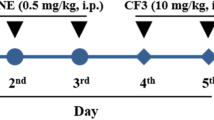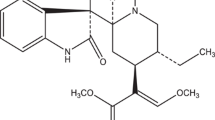Abstract
Chronic pain has consistently been correlated with depression. Echinocystic acid (EA), a natural triterpone enriched in various herbs and used for medicinal purpose in many Asian countries, exhibits anti-inflammatory and analgesic activities. However, little is known the effects of EA on the depression. In present study, we investigated the anti-depression activities in the mouse model of reserpine-induced pain-depression dyad. Reserpine (1 mg/kg subcutaneously daily for 3 days) caused significant depression-like behaviors and pain sensation. Subsequent treatment of EA (5 mg/kg intragastrically daily for 5 days) attenuated the reserpine-induced pain/depression dyad as shown by the increase of pain threshold and the behaviors in forced swimming test, tail suspension test, and open field test. Furthermore, treatment of EA reversed the decrease of biogenic amines (norepinephrine, dopamine, and serotonin) in the brain region of hippocampus, a structure involved in the formation of emotional disorders. Levels of serotonin receptor 5-HT1A were decreased and levels of 5-HT2A were increased in the reserpine-injected mice. Treatment of EA could restore the alterations of serotonin receptors. At the same time, the increase in GluN2B-containing NMDA receptors, p-GluA1-Ser831, PSD-95 and CaMKII were integrated with the increase in caspase-3 and iNOS levels in the hippocampus of the reserpine-injected mice. EA significantly reversed the changes of above proteins. However, EA did not affect the levels of GluN2A-containing NMDA receptors and the total levels of GluA1 and p-GluA1-Ser845. Our study provides strong evidence that EA attenuates reserpine-induced pain/depression dyad partially through regulating the biogenic amines levels and GluN2B receptors in the hippocampus.





Similar content being viewed by others
References
Albert PR, Lemonde S (2004) 5-HT1A receptors, gene repression, and depression: guilt by association. Neuroscientist: Rev J Bringing Neurobiol Neurol Psychiatry 10:575–593
Antkiewicz-Michaluk L, Wasik A, Mozdzen E, Romanska I, Michaluk J (2014) Antidepressant-like effect of tetrahydroisoquinoline amines in the animal model of depressive disorder induced by repeated administration of a low dose of reserpine: behavioral and neurochemical studies in the rat. Neurotox Res 26:85–98
Arora V, Kuhad A, Tiwari V, Chopra K (2011) Curcumin ameliorates reserpine-induced pain-depression dyad: behavioural, biochemical, neurochemical and molecular evidences. Psychoneuroendocrinology 36:1570–1581
Blier P, Abbott FV (2001) Putative mechanisms of action of antidepressant drugs in affective and anxiety disorders and pain. J Psychiatry Neurosci 26:37–43
Bliss TV, Collingridge GL (1993) A synaptic model of memory: long-term potentiation in the hippocampus. Nature 361:31–39
Bourin M, Mocaer E, Porsolt R (2004) Antidepressant-like activity of S 20098 (agomelatine) in the forced swimming test in rodents: involvement of melatonin and serotonin receptors. J Psychiatry Neurosci 29:126–133
Cates LN, Roberts AJ, Huitron-Resendiz S, Hedlund PB (2013) Effects of lurasidone in behavioral models of depression. Role of the 5-HT(7) receptor subtype. Neuropharmacology 70:211–217
Celada P, Puig M, Amargos-Bosch M, Adell A, Artigas F (2004) The therapeutic role of 5-HT1A and 5-HT2A receptors in depression. J Psychiatry Neurosci 29:252–265
Chaplan SR, Bach FW, Pogrel JW, Chung JM, Yaksh TL (1994) Quantitative assessment of tactile allodynia in the rat paw. J Neurosci Methods 53:55–63
Chen J et al (2015) Antidepressant-like effects of ferulic acid: involvement of serotonergic and norepinergic systems. Metab Brain Dis 30:129–136
De Benedetto GE et al (2014) A rapid and simple method for the determination of 3,4-dihydroxyphenylacetic acid, norepinephrine, dopamine, and serotonin in mouse brain homogenate by HPLC with fluorimetric detection. J Pharm Biomed Anal 98:266–270
Dellarole A et al (2014) Neuropathic pain-induced depressive-like behavior and hippocampal neurogenesis and plasticity are dependent on TNFR1 signaling. Brain Behav Immun 41:65–81
Drevets WC, Thase ME, Moses-Kolko EL, Price J, Frank E, Kupfer DJ, Mathis C (2007) Serotonin-1A receptor imaging in recurrent depression: replication and literature review. Nucl Med Biol 34:865–877
Dutta A, McKie S, Deakin JF (2015) Ketamine and other potential glutamate antidepressants. Psychiatry Res 225:1–13
Elhwuegi AS (2004) Central monoamines and their role in major depression. Prog Neuro-Psychopharmacol Biol Psychiatry 28:435–451
Fasick V, Spengler RN, Samankan S, Nader ND, Ignatowski TA (2015) The hippocampus and TNF: common links between chronic pain and depression. Neurosci Biobehav Rev 53:139–159. doi:10.1016/j.neubiorev.2015.03.014
Gene RM, Cartana C, Adzet T, Marin E, Parella T, Canigueral S (1996) Anti-inflammatory and analgesic activity of Baccharis trimera: identification of its active constituents. Planta Med 62:232–235
Guiard BP, El Mansari M, Blier P (2009) Prospect of a dopamine contribution in the next generation of antidepressant drugs: the triple reuptake inhibitors. Curr Drug Targets 10:1069–1084
Guo YY et al (2012) Acute stress induces down-regulation of large-conductance Ca2+−activated potassium channels in the lateral amygdala. J Physiol 590:875–886
Joh EH, Gu W, Kim DH (2012) Echinocystic acid ameliorates lung inflammation in mice and alveolar macrophages by inhibiting the binding of LPS to TLR4 in NF-kappaB and MAPK pathways. Biochem Pharmacol 84:331–340
Joh EH, Jeong JJ, Kim DH (2014) Inhibitory effect of echinocystic acid on 12-O-tetradecanoylphorbol-13-acetate-induced dermatitis in mice. Arch Pharm Res 37:225–231
Karolewicz B, Szebeni K, Gilmore T, Maciag D, Stockmeier CA, Ordway GA (2009) Elevated levels of NR2A and PSD-95 in the lateral amygdala in depression. Int J neuropsychopharmacol Off Sci J Collegium Int Neuropsychopharmacol 12:143–153
Khoshnoodi M, Fakhraei N, Dehpour AR (2015) Possible involvement of nitric oxide in antidepressant-like effect of silymarin in male mice. Pharm Biol 53:739–745
Lacivita E, Di Pilato P, De Giorgio P, Colabufo NA, Berardi F, Perrone R, Leopoldo M (2012) The therapeutic potential of 5-HT1A receptors: a patent review. Exp Opin Ther Pat 22:887–902
Li K et al (2013) betaCaMKII in lateral habenula mediates core symptoms of depression. Science 341:1016–1020
Liu SB et al (2014) Attenuation of reserpine-induced pain/depression dyad by gentiopicroside through downregulation of GluN2B receptors in the amygdala of mice. Neuromol Med 16:350–359
Molosh AI, Sajdyk TJ, Truitt WA, Zhu W, Oxford GS, Shekhar A (2013) NPY Y1 receptors differentially modulate GABAA and NMDA receptors via divergent signal-transduction pathways to reduce excitability of amygdala neurons. Neuropsychopharmacol Off Publ Ame Coll Neuropsychopharmacol 38:1352–1364
Monyer H, Burnashev N, Laurie DJ, Sakmann B, Seeburg PH (1994) Developmental and regional expression in the rat brain and functional properties of four NMDA receptors. Neuron 12:529–540
Murata Y, Yanagihara Y, Mori M, Mine K, Enjoji M (2015) Chronic treatment with tandospirone, a serotonin 1A receptor partial agonist, inhibits psychosocial stress-induced changes in hippocampal neurogenesis and behavior. J Affect Disord 180:1–9
Niciu MJ, Ionescu DF, Richards EM, Zarate CA Jr (2014) Glutamate and its receptors in the pathophysiology and treatment of major depressive disorder. J Neural Transm 121:907–924
Paoletti P, Bellone C, Zhou Q (2013) NMDA receptor subunit diversity: impact on receptor properties, synaptic plasticity and disease. Nat Rev Neurosci 14:383–400
Smith GR (1992) The epidemiology and treatment of depression when it coexists with somatoform disorders, somatization, or pain. Gen Hosp Psychiatry 14:265–272
Szewczyk B et al (2010) Decreased expression of Freud-1/CC2D1A, a transcriptional repressor of the 5-HT1A receptor, in the prefrontal cortex of subjects with major depression. Int J neuropsychopharmacol Off Sci J Collegium Int Neuropsychopharmacol 13:1089–1101
Tomaz VS et al (2014) Antidepressant-like effect of nitric oxide synthase inhibitors and sildenafil against lipopolysaccharide-induced depressive-like behavior in mice. Neuroscience 268:236–246
Vasquez CE, Riener R, Reynolds E, Britton GB (2014) NMDA receptor dysregulation in chronic state: a possible mechanism underlying depression with BDNF downregulation. Neurochem Int 79:88–97
Xu Y et al (2013) Ferulic acid increases pain threshold and ameliorates depression-like behaviors in reserpine-treated mice: behavioral and neurobiological analyses. Metab Brain Dis 28:571–583
Acknowledgments
This research was supported by National Natural Science Foundation of China, No. 31271144, 31325022, and 2013DFG32650.
Author information
Authors and Affiliations
Corresponding author
Ethics declarations
Conflict of interest
The authors declare that they have no conflict of interest.
Additional information
Shuo Li and Jing Han contributed equally to this work.
Rights and permissions
About this article
Cite this article
Li, S., Han, J., Wang, Ds. et al. Echinocystic acid reduces reserpine-induced pain/depression dyad in mice. Metab Brain Dis 31, 455–463 (2016). https://doi.org/10.1007/s11011-015-9786-6
Received:
Accepted:
Published:
Issue Date:
DOI: https://doi.org/10.1007/s11011-015-9786-6




